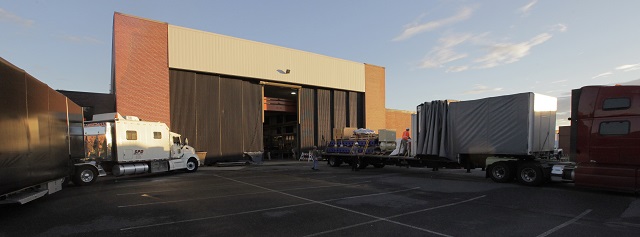 A huge crane from a local company barely had clearance to lift the ISAAC robot arm and set it down on the ground until technicians could install it on its track 40-foot long track. Image Credit: NASA/Kathy Barnstorff
A huge crane from a local company barely had clearance to lift the ISAAC robot arm and set it down on the ground until technicians could install it on its track 40-foot long track. Image Credit: NASA/Kathy Barnstorff
Researchers from NASA's Langley Research Center have designed a huge robotic arm that collects spools of carbon fibers and moves in a preprogrammed pattern to arrange these fibers in a 40-foot long bed, to fabricate aerospace structures and parts.
The project known as the Integrated Structural Assembly of Advanced Composites (ISAAC) was sponsored by the NASA Langley's Space Technology and Exploration Directorate, the Aeronautics Research Mission Directorate and the Space Technology Mission Directorate.
The robot was actually manufactured by Washington-based Electroimpact, and hence physically moving the system to the Hampton, Virginia facility was a real challenge for the researchers. The robot carried in two 53-foot long covered trucks is now present at the NASA Langley's Advanced Manufacturing and Flight Test Articles Development Laboratory.
Following this, the team used a massive crane to lift the ISAAC and place it on the floor. According to one of the team members, the clearance between the ceiling and crane was just few inches while lifting the robot arm. Using the same crane, the arm was laid on the track to arrange the composite fibers.
Researchers expect to start the operation of ISAAC by early 2015, providing enough time for the Electroimpact technicians to ensure the operation of all electronics and other components of robotic arm. The project is a result of a public-private partnership aimed at minimizing the costs and time associated with the development, analysis and regulatory acceptance of new, advanced composite technology and its design method. NASA has planned to meet these requirements through the use of new inspection techniques, test protocols and rigorous computational methods.
ISAAC Robot Arrives at NASA Langley
The ISAAC robotic system, which recently arrived at NASA Langley, will manufacture composite structures and parts. Image Credit: NASA/Gary Banziger
The ISAAC system will be implemented in the NASA's space projects, followed by the Composites for Exploration Upper Stage Project which is a result of partnership between the Human Exploration Mission Directorate and the Space Technology Mission Directorate.
We have worked for two years to obtain this precise robotic technology. But we proposed the idea more than six years ago. It will really make a difference in our ability to understand composite materials and processes for use in aviation and space vehicles.
Chauncey Wu, a structural mechanics engineer in ISAAC project
References